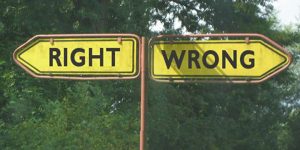 At least one time every day I check on the News, perusing Local, National and Global events.
At least one time every day I check on the News, perusing Local, National and Global events.
My personal approach these days is to scan both ends of the media spectrum to try and decipher the reality of any significant situation. It’s often the best methodology to pursue nowadays.
This system is typical; excepting for those whose time, affiliations and/or curiosity cause them to visit only one pole of available coverage.
And, in the process I am amazed daily by news of behavior exhibited by one faction(/person) or another.
There is always some act, crime or deed been perpetrated which makes me wonder, “Why would they do that?”
I doubt my feelings are unusual, but rather quite common.
It makes you question if people “Know Right from Wrong.” And upon reflection, I doubt they do. Let me explain…
There is little formal training in most cultures that comprehensively delineates RIGHT from WRONG Actions, Thought and Behavior.
Yes, there are LAWS. These may be laid down by Civil (or Military) authorities and Religious Institutions.
Also, there are Expectations, Common Sense and Social Pressures in-play.
Parents and Teachers typically provide their influences.
But there are few, systematically organized, comprehensive Codified Listings from  which we can readily learn. Rather, we sit before a smorgasbord of exposures. This arrangement facilitates individual perspectives being formed.
which we can readily learn. Rather, we sit before a smorgasbord of exposures. This arrangement facilitates individual perspectives being formed.
Our complex sense of RIGHT and WRONG is built and formed by our cultures, written Laws and conventional expectations; unspoken pressure for conformity is enormous.
Religion-based missives paint pictures of guiding principles to embrace and fast rules we should honor.
Written Laws enumerate numerous circumstances we may encounter.
And still all this combined can in no way encompass and specifically list everything that is RIGHT or WRONG.
We rely on Common Sense to fill in the gaps. As is often mentioned, such sense can be far from common.
Additionally, people operate primarily principled by what suits their purpose; they act in their own interests. In such instances thoughts of what is Moral, Correct, Right or Wrong can often immediately fly out the window.
So, disconcertingly, our OWN opinion of what constitutes RIGHT or WRONG is far from universal. For example…
In most Western Cultures killing is typically considered Wrong. Yet Vendettas, Honor Killings and Dispatching (commonly held) Enemies is acceptable; indeed, it is considered Right and even necessary.
That’s’ a massive disparity in perspective and between Cultural Rules.
And it continues. One Culture demands Monogamy, another Polygamy.
Other groups demand adherence to one religion and sometimes the destruction of all competing ideologies and religions. Opposing views are generally considered WRONG and often dangerous.
One reporter portrays an event in a particular way and a colleague from another publication might file an almost opposite spin.
In each of these different instances all parties believe they are in the RIGHT; additionally, they specifically believe the other side is also, WRONG. And, they might push their agenda.
Logically, in a world of absolutes (and ignoring Schrodinger’s Cat) these conflicting truths cannot co-exist.
In the end RIGHT and WRONG becomes a personal view.
Our individual versions of Right & Wrong are determined by our programming through…
- DNA
- Culture
- Experiences
- Exposure
- Perspective
- Position and,
- Self-Interest(s)
So, aligning quarreling people within a single philosophy and an understanding of what is correct and appropriate is daunting if not often impossible.
To avoid tragedy, conflict and warring, humans need accept the fact that others often do NOT share the most basic common understanding of what is RIGHT or WRONG.
Securing such acceptance inevitably precedes any meaningful progress and collaboration between colliding groups, cultures and peoples.
And so too, the individual. If they do not in some way buy-into the prevailing standard (Right and Wrong) of the culture in which they exist, they are probably on a social collision course.
Religions frequently offer the greatest opportunity for conflict: If ONLY ONE is truly RIGHT are all others inherently WRONG and so damned? 
Analogously, supposedly objective individuals, wholly bound to specific political parties (in (say) a two-party situation) frequently find themselves absurdly tied to questionable arguments some “fifty percent of the time.” But still most hold the party line.
Both sides in every argument believe only they are RIGHT.
These vast dichotomies cause us to posit the question, “Is there ever a case of complete RIGHT or WRONG?” Is everything ultimately a truly grey area when fairly considered from all sides?
And unfortunately, when views become fixed and are re-enforced it is easy to manufacture and escalate conflict; inflexible people are easily manipulated.
Now look at the News. What we see can be truly alarming.
Consider the actions and behaviors of individuals, groups and people featured…
Don’t agree with what’s happening?
The protagonists aren’t always bad, mentally diseased people or sociopaths. Often, they just don’t share your view of what is RIGHT or WRONG. And they have their own agendas.
When you encounter things you don’t like, consider the perspective, position and nature of those involved. We may not like what we see, but the other side usually believes they have a valid point.
Ian R. Mackintosh is the author of Empower Your Inner Manager Twitter@ianrmackintosh.
